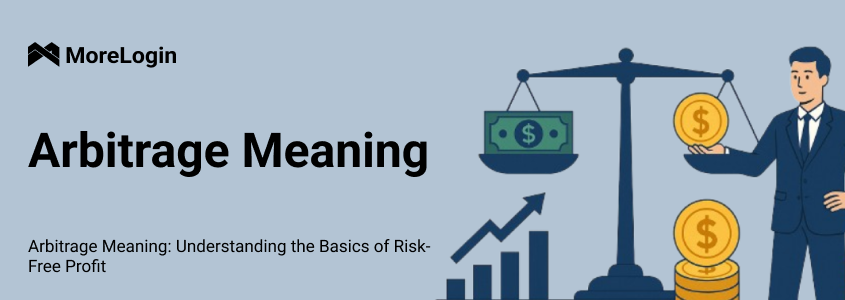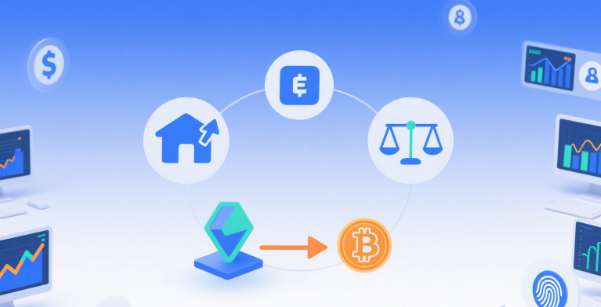
- Product

- Pricing
- Affiliate Program
- Use Cases
- Resource


In financial markets, arbitrage meaning is often associated with "risk-free profit." The core appeal of arbitrage lies in its relatively low risk and quick returns. Whether in stocks, forex, or cryptocurrency markets, arbitrageurs profit by exploiting price discrepancies while helping balance market prices. However, these opportunities are usually short-lived.
This article explores the definition, types, risks, and real-world applications of arbitrage.
So, what does arbitrage mean? It refers to buying and selling the same asset in different markets to profit from price differences. For example, an arbitrageur can buy a stock for $100 in New York and immediately sell it for $102 in London. This earns a $2 profit per share.
Arbitrage arises due to market inefficiencies. When an asset is priced differently across markets, arbitrageurs act quickly to capitalize on the imbalance, pushing prices back to equilibrium. This strategy applies not only to traditional finance but also to forex, commodities, and even cryptocurrencies.
The key elements of arbitrage trading are timing and cost. Since price differences may disappear quickly, we need to act fast to complete trades. At the same time, we must control costs. Transaction fees, exchange rate losses, and other expenses must be lower than arbitrage profits to generate a profit.
There are a variety of arbitrage strategies, and the following are a few common types and examples of their practical application.

Spatial arbitrage is the most basic form of arbitrage, capitalizing on price differences of the same asset in different geographical markets. The price of gold on the New York Mercantile Exchange (NYMEX) and the Shanghai Gold Exchange (SGE) can differ due to supply, demand, or exchange rate fluctuations. Traders can profit by buying low in one market and selling high in the other.
Temporal arbitrage involves exploiting price differences of an asset at different points in time. For instance, futures contracts typically trade at a premium to spot prices. Traders can buy the asset in the spot market while simultaneously selling futures contracts, locking in profits when prices converge at expiration.
Take the crude oil market as an example: Suppose the spot price is $75 per barrel, while a 3-month futures contract trades at $78. A trader could purchase 100,000 barrels of crude oil in the spot market for $7.5 million while selling 100 futures contracts (each representing 1,000 barrels). At expiration, regardless of oil price movements, the trader secures a $3 per barrel profit, as long as transaction costs remain below $300,000.
Common in forex markets, triangular arbitrage exploits inconsistencies in exchange rates among three currencies. Assume 1 USD directly converts to 100 JPY, but we find that 1 USD equals 0.9 EUR, and 1 EUR equals 110 JPY. By converting USD to EUR, then EUR to JPY, we effectively exchange 1 USD for approximately 111 JPY. Converting the JPY back to USD completes the arbitrage loop (USD→EUR→JPY→USD).
Although arbitrage is often referred to as “risk-free profit”, there are potential risks.
Arbitrage opportunities in markets are often fleeting, disappearing in the blink of an eye. Any delay in trade execution may cause the price discrepancy to vanish or even reverse, resulting in losses.
High-frequency trading firms typically employ algorithms to swiftly capture these opportunities, putting retail investors at a competitive disadvantage. Experienced arbitrageurs use direct market access (DMA) to reduce execution risk. They trade during high liquidity hours and set strict automatic stop-loss orders to protect against price reversals.
In illiquid markets, large-volume trading can significantly impact prices, rendering arbitrage strategies ineffective. In thin markets, large trades can significantly move prices. Arbitrage professionals require specialized techniques. They break down large orders into smaller lots. These are then executed gradually.
Prudent traders prioritize highly liquid markets. These markets typically have daily trading volumes exceeding $100 million. They also continuously monitor market depth data. This allows them to assess real-time liquidity conditions.
Cross-border arbitrage may encounter exchange rate fluctuations and policy restrictions. Some countries impose capital flow controls that can disrupt arbitrage transactions.
To manage these risks, professional firms take multiple steps. First, they spread investments across stable developed markets. Second, they lock in exchange rates using forward contracts. Third, they keep full-time teams watching international capital movement rules.
Mature arbitrage institutions enforce strict opportunity screening criteria. They only pursue high-quality trades where the price gap is at least three times the transaction cost. Additionally, they limit any single arbitrage position to no more than 2% of their total capital.
Traders use multi-market monitoring systems to track arbitrage opportunities in real time. They also conduct regular stress tests. These tests evaluate strategy performance during extreme market conditions. Through these measures, professional institutions can maintain arbitrage trading annualized volatility below 5% while achieving Sharpe ratios above 3.
For individual investors, starting with simulated trading is advisable. This helps build experience before moving to live accounts. It is also important to understand that truly risk-free arbitrage opportunities are extremely rare in real financial markets.
Arbitrage not only exists in theory but also has a wide range of applications in several fields, including the growing area of rental arbitrage, meaning in real estate markets where investors lease properties to sublet at higher rates.

In stock markets, ETF arbitrage is a common strategy. ETF stands for Exchange Traded Fund, a name that perfectly describes its characteristics: tradable, open-ended index funds. When an ETF's market price deviates from its net asset value, institutional investors can buy the underlying stocks and redeem ETF shares, or vice versa, to profit.
With numerous cryptocurrency exchanges offering different prices, digital arbitrage meaning becomes particularly important. For example, when Bitcoin trades $50 lower on Binance than on Huobi, traders can exploit this price difference for arbitrage profits.
In the DeFi space, arbitrageurs engage in unsecured arbitrage between different protocols through flash lending. If a token has a different price at Uniswap and Sushiswap, a trader can borrow funds to arbitrage and return the loan, with the entire process completed in a single transaction.
To improve arbitrage efficiency, you can use TradingView's multi-chart linkage feature to help traders compare price movements in different markets in real time.
For arbitrageurs who need to manage multiple exchange accounts at the same time, MoreLogin offers a multi-account management system. This system effectively addresses the risk of account linkage. And its browser fingerprint emulation technology ensures that each trading account has an independent digital identity. These can help track price changes across multiple trading platforms simultaneously.
The essential arbitrage meaning revolves around exploiting temporary price differences for profit. While not completely risk-free, understanding arbitrage meaning and implementing proper risk controls can make a valuable strategy. From spatial arbitrage to triangular arbitrage, different strategies apply to various market conditions.
Using tools properly can significantly boost our arbitrage trading profits. Monitoring tools help track market data to facilitate quick trading decisions. Therefore, we should use tools wisely for management. For example, Morelogin is very practical for multi-account management. If you have many accounts during arbitrage, you can use Morelogin to manage them. This saves time on routine tasks. It also frees up more energy for arbitrage operations.